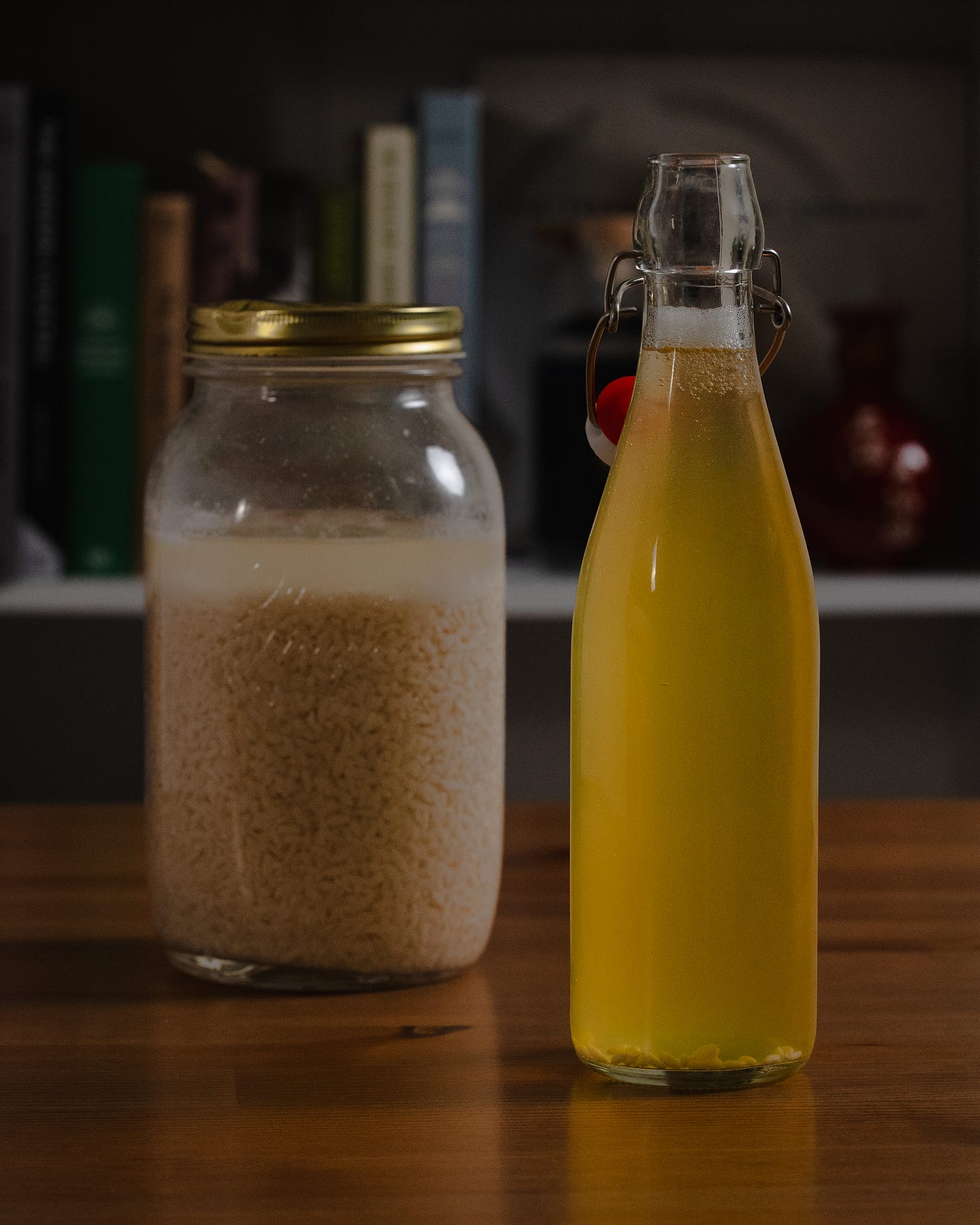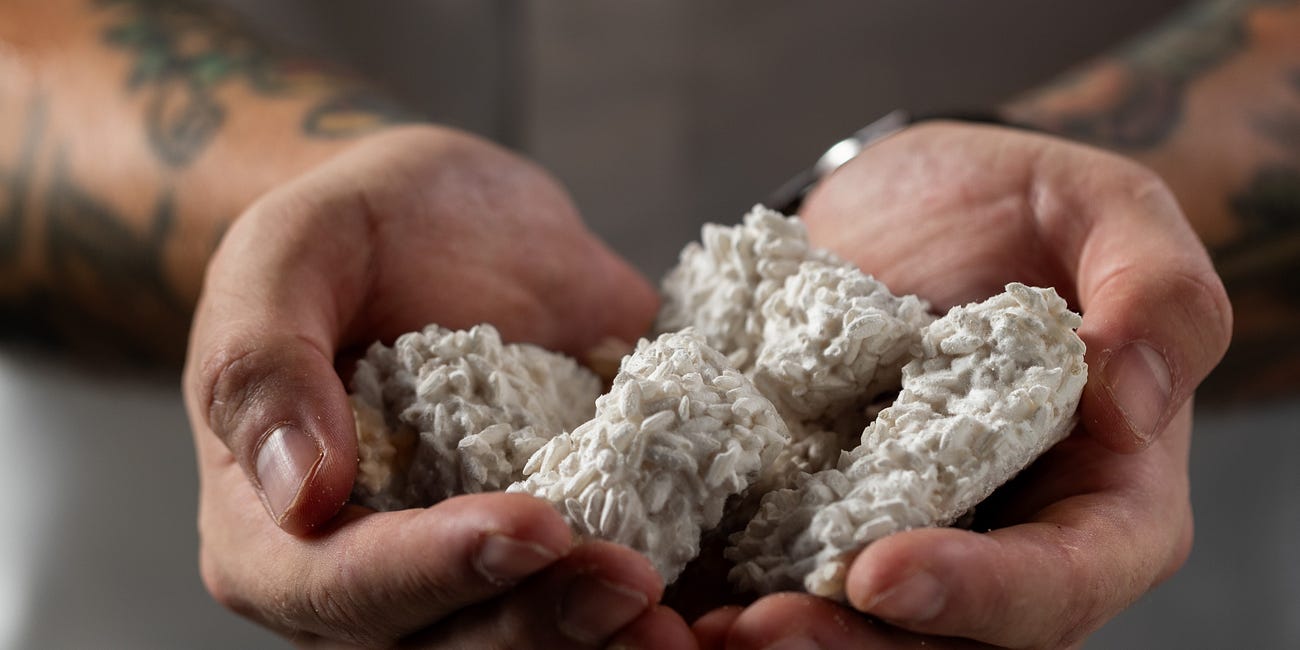Lacto-Fermented Amazake Soda: A Naturally Sweet & Sour, Umami-Rich Probiotic Drink
Sugar-free koji soda recipe - learn to make healthy probiotic amazake soda with no added sugar
Amazake, a traditional Japanese sweet rice drink, is made by fermenting rice with koji (Aspergillus oryzae). The enzymes in koji break down rice starches into simple sugars, creating a naturally sweet, nutrient-rich liquid. By fermenting this liquid with water kefir grains or ginger bug, we transform it into a fizzy, probiotic-rich soda—without any added sugar.
Unlike commercial sodas or even kombucha, this method leverages koji’s enzymatic power to provide all the sugar needed for fermentation. The result is a well-balanced, tangy drink with a deep umami aftertaste—a signature of koji fermentation.
The Science Behind Amazake Soda Fermentation
This process combines two key microbial actions:
Enzymatic Sugar Release (Amazake Stage)
Koji’s enzymes (amylase, glucoamylase) break down rice starches into glucose and maltose.
Incubate at 50–60°C for 8–10 hours (sous vide recommended for precision).
The strained liquid is diluted to 8–10°Bx, ideal for LAB fermentation.
Lactic Acid Fermentation (Soda Stage)
Water kefir grains or ginger bug introduce LAB (Lactobacillus) and wild yeast.
Fermenting at 20–24°C for 3–4 days ensures a robust LAB profile.
Final pH drops to 3.5–4.0, delivering a bright acidity and lingering umami depth.
Key Benefits of This Method
✔ No added sugar – Koji enzymes provide all fermentable sugars naturally.
✔ Rich umami complexity – Koji’s proteolytic activity enhances flavor depth.
✔ LAB-dominant – Promotes gut-friendly bacteria over excessive yeast.
✔ Customizable – Fruits/herbs can be added for secondary fermentation.
Note on Water Kefir Grains Maintenance
Water kefir grains require sugar to thrive. After each amazake soda batch, rejuvenate them in a 8% sugar-water solution for 24–48 hours before reuse.
Recipe: Lacto-Fermented Amazake Soda
Ingredients
Amazake Base:
500 g rice koji (Aspergillus oryzae-inoculated rice)
750 g water or tea (lightly brewed tea or herbal infusion)
Fermentation Starter:
1 tbsp active water kefir grains (or 50 ml ginger bug liquid)
Optional for Secondary Fermentation:
100 g fruit or puree and/or herbs
Equipment
Sous vide setup (or warm fermentation chamber – a rice cooker at “Keep Warm” mode)
Cheesecloth/fine strainer
Fermentation jar
Refractometer (for °Bx)
pH strips/meter
Method
1. Prepare the Amazake Liquid
Mix rice koji and water/herbal tea in a sous vide bag or jar.
Incubate at 55°C for 8–10 hours.
Strain through cheesecloth, pressing to extract all liquid. Discard solids.
Dilute with water to 8–10°Bx (measure with brix refractometer).
2. Primary Fermentation (Culturing with LAB)
Combine strained amazake liquid and water kefir grains / ginger bug liquid in a clean jar.
Cover with a breathable cloth or loose lid.
Ferment at 22–25°C for 2 days (if using water kefir grains, strain them out after 48 hours)
Transfer into a sealed bottle and at 20–24°C for 2 more days for carbonation.
Check pH: Target 3.5–4.0 (tangy and umami-rich).
3. Secondary Fermentation – Optional (Flavor & Carbonation)
Add fruit/herbs if desired.
Leave 5cm headspace and seal tightly.
Ferment at 20–24°C for 2 days, then cold-crash in fridge for 24 hours.
4. Serving & Storage
Chill before opening to retain carbonation.
Store refrigerated for up to 3 weeks.
Troubleshooting Tips
Weak acidity? Extend fermentation by 1 day.
Overly fizzy? Reduce secondary fermentation time.
Why This Soda Stands Out
Amazake soda is not just another probiotic drink—it’s a harmony of science and tradition. The koji-driven process ensures a perfect balance of sweetness, acidity, and umami, while LAB fermentation adds gut-health benefits.
Ready to experiment? Share your results with us at info@cosmos-society.com or tag us on Instagram @cosmos.society.concepts and explore more koji-based fermentations!
Another amazake-based LAB-driven fermentation:
Double-Fermented Amazake Yogurt
Fermenting yogurt from amazake is a two-step fermentation process that leverages the enzymatic activity of Aspergillus oryzae (koji mold) to break down starches into fermentable sugars, which are then metabolized by lactic acid bacteria (LAB) to produce yogurt. This innovative approach transforms amazake, a traditional Japanese rice beverage, into a creamy and tangy plant-based yogurt. By combining the enzymatic breakdown of starches with LAB fermentation, this method provides a unique way to create a plant-based yogurt with complex flavors and natural sweetness.
connect with us on Instagram:
Denis Pashkov
cosmos society




